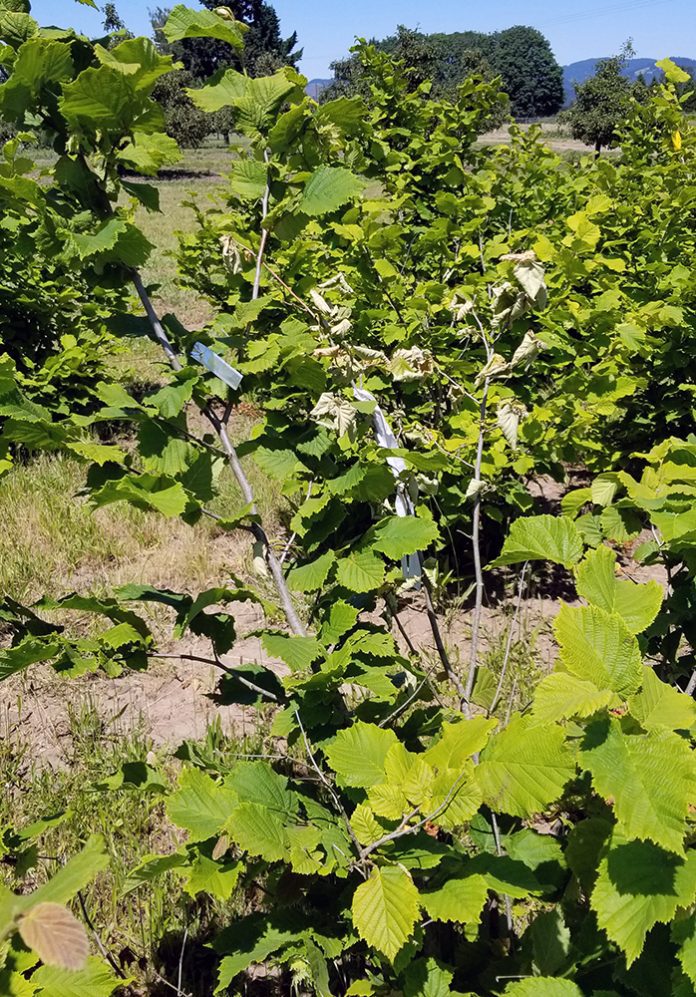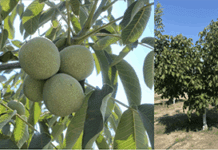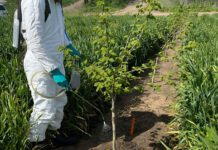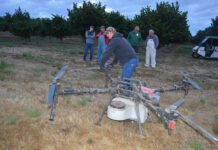
A bacterial disease particularly harmful to young hazelnut trees has become nearly ubiquitous in Oregon’s hazelnut acreage, according to an Oregon State University (OSU) plant pathologist, to the point where ignoring it can lead to significant tree loss.
“We are seeing hazelnut bacterial blight fairly steadily out there,” said Jay Pscheidt, a professor in the Department of Botany and Plant Pathology at OSU. “If you are planting new acreage, it is something to be aware of and put in preventative control tactics.”
Caused by the bacterium Xanthomonas arboricola pv. corylina, the disease’s rise in importance has essentially paralleled the rapid increase in hazelnut acreage over the past twenty years, Pscheidt said.
“That is why we are seeing so much of it,” Pscheidt said, noting that acreage planted to hazelnuts in the Willamette Valley has grown from around 25,000 acres in the early 2000s to about 95,000 today.
“It is increasing in incidence with the rising acreage and just the predominance of young trees out there,” added Nik Wiman, OSU Extension orchard crops specialist.
The disease can lead to branch and twig dieback and yield reduction on trees of any age, Pscheidt said, but its biggest impact is in newly planted orchards where it can kill trees. Also, Wiman said, if the disease gets a foothold in a young tree, it can become a chronic problem.
“You can get these cankers in the trunk that just slowly over time get worse and worse until eventually they interfere so much with the vascular tissue that the tree can no longer regulate water very well,” Wiman said. “Some of these things just take a while to really run the course, so growers might not notice symptoms until it becomes obvious that the tree is having a hard time getting water up into the branches.”
Bacterial blight appears as small, angular or round yellowish green water-soaked spots on leaves that later turn reddish brown. Infected buds may turn brown and fail to leaf out, and in some cases, leaves may emerge from infected buds but then wither and turn brown. Infections on current-season stems will appear as dark green water-soaked areas on bark, which turn reddish brown.
The bacterial blight pathogen enters plant tissue through open stomata on leaves and wounds, and it can survive from one season to another in cankers and infected buds.
Rain splash or movement of infected nursery stock can spread the bacterium, and moisture must be present on the plant tissue for infection to occur, according to literature. Disease incidence is also favored by freezing weather.
Avoid Drought Stress
Two keys to avoiding issues with the disease, according to Pscheidt, are to avoid drought stress early in the life of a tree, particularly during the first summer after planting, and to apply a preventative treatment in the fall the first few years after planting.
“Preventing drought stress that first summer, and in fact for the first several years of an orchard, is very helpful,” Pscheidt said. “We know that drought-stressed trees are more susceptible to this bacterial disease than trees that have been irrigated. So, we want to make sure that in the summer after we plant that we’re irrigating.”
Also important, according to Wiman, is to plant orchards as early as possible in the dormant season, given that late-planted trees can be more susceptible to drought stress. And coming in with a copper treatment, particularly that first fall after planting, is critical, Pscheidt said.
“Those new little trees are very susceptible to hazelnut bacterial blight,” Pscheidt said. “And if we skip that copper application, we might see more problems later in the life of the orchard.” The copper should be applied just ahead of the first fall rains, he said.
Copper applications have no curative effect, Wiman noted, but can help reduce the spread of bacterial blight by preventing bacteria from colonizing plant tissue.
Pscheidt added that a spring application of copper does not appear to enhance disease prevention if a fall application was previously used.
“The data suggest that if we have a copper application on in the fall, we don’t really need any spring application,” Pscheidt said. Minus a fall application, a spring treatment appeared to provide control only two out of five times, he added.
Once a tree is more established and more resistant to drought stress, it is less susceptible to bacterial blight.
“At that point, there is definitely a lot less threat from the Xanthomonas bacteria,” Wiman said. “There can still be low levels of infection around the periphery of the canopy. We see that sometimes even in mature trees. But we don’t really know the impact that has on the overall productivity of the orchard. That has never been studied. But we suspect that there’s a low level of bacterial blight even in mature trees that is maybe having some effect.”
“We have seen problems in older trees where sometimes you lose a branch or a part of a tree and we can get some twig dieback in the top of the canopy,” Pscheidt said. “But it is nothing like having mortality early in the life of the orchard. We definitely want to avoid that.”
Other Strategies
Other control strategies mentioned in literature include planting pathogen-free nursery stock in early winter; pruning out infected twigs and branches; controlling sunburn during summer using shields or white paint on trunks; mulching around the base of newly planted trees with woodchips or compost to reduce moisture stress; and applying nitrogen fertilizer in the spring based on leaf-tissue analysis from the prior August.
When pruning out infected twigs and branches, the literature advises to make cuts two to three feet below the affected branches and to soak pruning tools between cuts with a shellac thinner of 70% ethyl alcohol and 10% Clorox. Disinfectants work better on clean equipment with long contact times, the literature states. Further, it advises growers to use the two-pruner method, having one soaking in the solution while using the other, and to change solution every two to three hours.
Wiman noted that biological products are being used by growers to fight bacterial diseases in tree fruits and hazelnuts, but, he said, there is not enough information from hazelnuts to support recommendations.
“There are all kinds of options that claim control of bacteria,” Pscheidt added. “But we have not tested a lot of those right at the moment. We are planning to do that, but right now, the research is focused on how we test those materials.”
Pscheidt said he is preparing trials to screen alternative compounds and hopes to know more on this topic after this spring. “Right now, we are just trying to figure out a good way to do it,” he said.
With hazelnut acreage continuing to increase in Oregon, Pscheidt said it is unlikely that the amount of the hazelnut bacterial blight pathogen will decrease in the Willamette Valley any time soon. But if growers stay on top of the disease, they may be able to significantly minimize its effect on hazelnut production.















